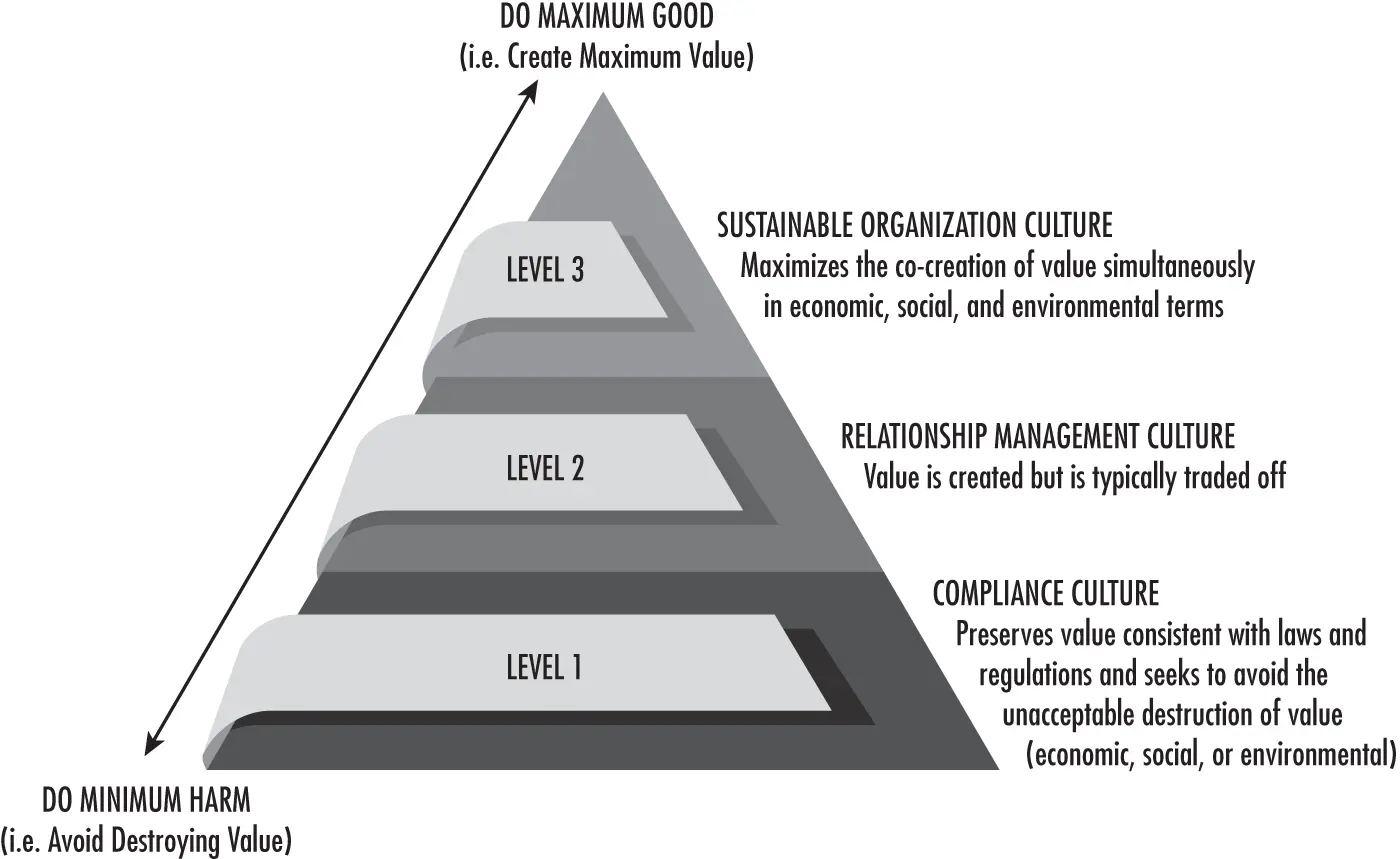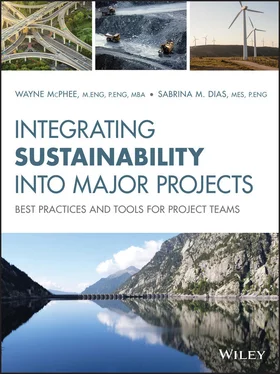Lost productivity is a potential and often overlooked cost to a project, whether it is due to dissatisfied employees, high turnover, or community blockades that delay construction. Integrating sustainability into the project, especially into construction management, can help to keep the local workforce engaged and productive. If there are unresolved issues with the local community then the project could experience a disengaged or angry local workforce that has high absenteeism, low productivity, and high turnover, all of which lead to higher costs of project delivery.
1.3 Creating a Sustainability Focus
There are a number of different ways to think about sustainability. Some people understand sustainability to be only about renewable energy or green buildings. Others think sustainability is about engaging with the local community or philanthropic donations to a local charity. In our approach we think about sustainability as a focus on creating the maximum positive impact and the minimum negative impact from a project. This goes beyond meeting regulatory requirements and involves all elements of the project.
This section examines some of the models that the project team can use to create a sustainability focus across the entire project. We look at the evolution of organizations from being compliance focused to being sustainability focused, how project teams can focus on managing sustainability, and how to think about complexity and social capital.
Sustainability versus Compliance
We believe that an impactful focus for project teams is to move beyond a compliance culture and pursue sustainability in design, procurement, and construction. Creating a better, more sustainable project reduces overall risks, improves financial performance, and ensures that the project leaves a positive legacy that everyone on the team can be proud of.
A simple but effective diagram is the sustainability versus compliance graphic (see Figure 1.1), by Wheeler, Colbert, and Freeman (2002). 2 This clearly shows how an organization can shift from a culture of compliance to a culture of relationship management, and eventually to a culture of sustainability where maximum value is created.
This model can be applied to the evolution of delivering major projects. Traditionally, organizations and project teams have focused on getting the required permits for a project with limited engagement with stakeholders and local communities. More recently, projects have moved to a relationship management approach where stakeholder engagement is considered a necessary requirement for major projects. However, the engagement is still typically performed by a small team focused on getting project approvals rather than creating long-term relationships with the local community. Integrating sustainability into major projects is focused on building a culture of sustainability across the entire organization where the team looks at building value for both the project owners and the local community.

Figure 1.1Sustainability versus compliance. Adapted from Wheeler, Colbert, and Freeman (2002) reproduced with permission of the Journal of General Management .
Sustainable Project Management
Another way to think about project sustainability is outlined in Figure 1.2, which shows how projects can be considered sustainable in two ways. A project is plotted based on its underlying sustainability features (x-axis) where some projects, such as a wind farm, are typically considered to be “sustainable projects” and thus are placed further to the right on the x-axis. On the other hand, nonrenewable resource extraction projects, such as a mine, are considered unsustainable by their fundamental nature (i.e. removing a resource from the earth that will not be replaced) and so are placed further to the left on the x-axis.
An alternative view (on the y-axis) is to look at how the project is managed to improve its overall sustainability. For example, a typical mine that extracts a nonrenewable resource may not be considered fundamentally sustainable, but if development can be managed to mitigate environmental impacts, reduce energy requirements, and create benefits for local communities, then it can still create a positive benefit. In this case, the mining project would move from a low position on the graph to a higher, more sustainable position.

Figure 1.2Sustainable project management model.
Conceptually, the sustainability focus for the project team should be on how they can move the project as far as possible to the upper right of the graph while maintaining the underlying organizational objectives.
Project teams rarely have control over the underlying sustainability features of the project that they are working on. But they do have the ability to improve project management and delivery to reduce negative impacts and improve benefits. One of the core themes of this book is to help project teams define what sustainability means for their project and then provide tools and systems to help them achieve that vision and focus.
Complexity Is the New Reality
Managing major projects is a messy and complex business. It is getting even more complex with competing priorities for budget, schedule, quality, safety, environment, security, and community. Project teams need to develop the skills, tools, workflows, and thought processes to manage these competing priorities, make informed decisions, and create new solutions that help meet often contradictory project goals. These challenges are also opportunities for innovation, for new approaches, and for collaboration to solve problems.
A key starting point in developing a mindset about sustainability is to be aware that there will be both competing and complementary objectives between the traditional technical and financial goals, and the sustainability goals. Project teams need to embrace this complexity and view sustainability as an opportunity to create a better project, rather than as an annoyance and additional cost. In Reconstructing Value: Leadership Skills for a Sustainable World, the authors refer to this approach as a “sustainability Mindset,” where there is a synthesis of these competing challenges rather than just a compromise:
A sustainability mindset holds that the key challenge is in advancing human development in areas such as prosperity, justice and human rights, while at the same time preserving nature and respecting the regenerative limits of the biosphere. 3
The sustainability mindset understands that new major projects are essential to human development but also looks to ensure that the work is done with respect for the environment and the local communities impacted by the project.
Sustainability is creating more complex business and technical environments, and project teams cannot manage increasing project complexity with the same processes and tools that have been used for years. Project teams need to look for ways to improve existing tools and processes to incorporate sustainability. They need to introduce new tools that help manage the increasing complexity, shift roles and responsibilities, and diversify project teams to bring in new and varying skills sets to ensure that sustainability challenges are managed.
By our nature, we are more comfortable solving problems that are familiar. However, with the rapid changes occurring in the world, project teams are often faced with new problems that don't have proven solutions. If we are going to meet the challenges of this new reality, we will need to adapt and find new ways of collaborating and working together to solve problems.
Читать дальше














